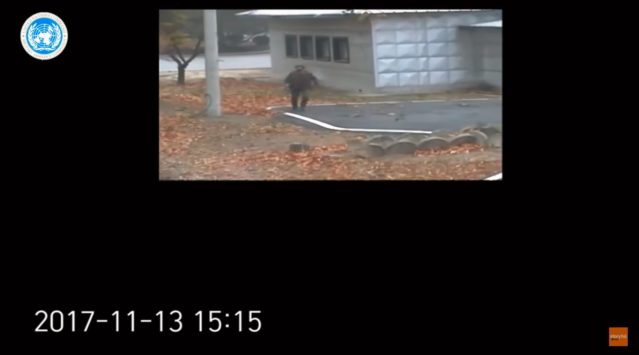PETER HAYES
FEBRUARY 13, 2018
I. INTRODUCTION
In this essay, Peter Hayes argues: “In short, sudden surprise events, the use of weapons, and subsequent escalation remain all too possible at the JSA. It is essential that the tension be reduced and underlying conditions that lead to defections be addressed while the Korean conflict is resolved in a comprehensive manner. This future management structure must address all the matters referred to in the Subsequent Agreements, not just the original Armistice.”
Peter Hayes is Director, Nautilus Institute and Professor, Center for International Security Studies, Sydney University.
Acknowledgment: This report was funded by MacArthur Foundation.
The views expressed in this report do not necessarily reflect the official policy or position of the Nautilus Institute. Readers should note that Nautilus seeks a diversity of views and opinions on significant topics in order to identify common ground.
Banner Images: KPA soldier crosses the MDL, JSA, November 21, 2017, UNC video, here.
II. NAPSNET BLUE PETER ESSAY BY PETER HAYES
MANAGING THE JOINT SECURITY AREA AND THE RISK OF WAR IN KOREA
FEBRUARY 13, 2018
The 1953 Armistice remains a live document and defines the framework in which military forces are to be managed in the Korean Peninsula. In many respects, it has been surpassed on the ground by the disposition and types of forces that both sides have introduced into Korea, and specifically in and around the Demilitarized Zone over the last six and a half decades. The Korean Peninsula is now in a state of non-war under international law, a kind of limbo of Cold Peace rather than Hot War. All parties to the conflict would have to renew their political and military obligations to start war anew.
Meanwhile, the Armistice is the primary institutional framework for ensuring that the signatories to the Armistice, the United States, China, and the DPRK, and the ROK and other US allies via their commitments under UN Command or by virtue of an alliance relationship with the United States (most importantly Japan) do not come to blows inadvertently.
There are multiple pathways to ending the Armistice in a political and legal manner as part of a “peace regime” in Northeast Asia.[1] Thus, the Armistice remains highly salient and bears careful reading.[2]
What is less well known is that in addition to the Armistice with its array of live (UN Command or UNC), part-alive (Military Armistice Commission), and part-moribund organizations such as the Neutral Nations Supervisory Commissions, a set of post-Armistice also exist that define some of the most important aspects of day-to-day practices aimed at reducing the risk of collision between US, ROK, and DPRK soldiers.
These are known as the “Subsequent Agreements.” They are listed below, and the full texts may be found here.
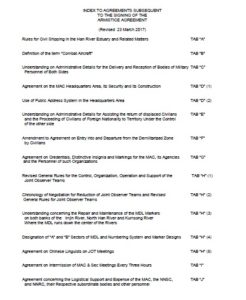
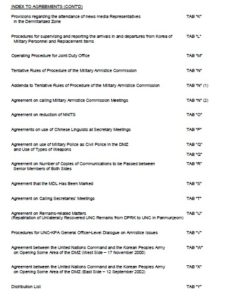
Source: United Nations Command, “INDEX TO AGREEMENTS SUBSEQUENT TO THE SIGNING OF THE ARMISTICE AGREEMENT (Revised 23 March 2017)
As the Subsequent Agreements are part and parcel of the Armistice itself, it is important that they be included in any consideration of post-Armistice arrangements to manage the Demilitarized Zone and other related security concerns.
Partitioning of the Joint Security Area
Of these, none is more important than that which redefined the physical arrangements of the Joint Security Area (JSA) at Panmunjon. This rearrangement took place in 1976 after the near-war that took place after the altercation between North Korean soldiers and a US-ROK team sent to cut down a poplar tree blocking the view to the North in the JSA. Before this collision, soldiers from the United States and the two Koreas regularly engaged in provocative behavior such as “stare-downs” and spitting that led to physical fighting on occasion, but it took the 1976 incident to force the changes which were made after North Korea proposed on August 25, 1976 the JSA’s partition to avoid future such incidents (as recorded in the US history of the MAC meeting below).[3]
EXCERPT FROM 1976 Annual Historical Report USFK/EUSA
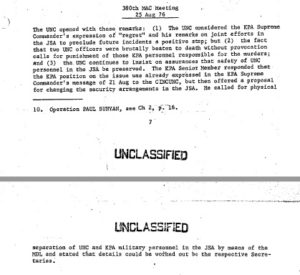
Source: 1976 Annual Historical Report USFK/EUSA, p. 7, released to Nautilus Institute under a US Freedom of Information Act request, at: https://nautilus.org/foia-document/1976-annual-historical-report-usfkeusa/
North Korea made this proposal and implemented even though they gave up four guard posts in the southern part of the original JSA, and UNC forces gave up none (having none north of the MDL in the original JSA).[4]
A copy of the September 6, 1976 “Agreement on Supplement to the “Agreement on the Military Armistice Commission Headquarters Area, Its Security and Its Construction,” to partition the JSA is found in Appendix 3 to the 1976 Annual Historical Report of US Forces Korea/Eighth US Army.[5] However, this document did not include the layout diagrams and maps pertaining to the JSA that were part of this Agreement. It did summarize these changes as outlined in the following excerpt from the 1976 Annual Historical Report USFK/EUSA:
EXCERPT FROM 1976 Annual Historical Report USFK/EUSA
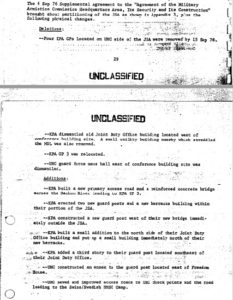
Source: 1976 Annual Historical Report USFK/EUSA, pp. 29-30, released to Nautilus Institute under a US Freedom of Information Act request, at: https://nautilus.org/foia-document/1976-annual-historical-report-usfkeusa/
In 1986, UNC issued “Compliance with the Armistice Agreement”[i] which included the revised layout, shown below.[6]
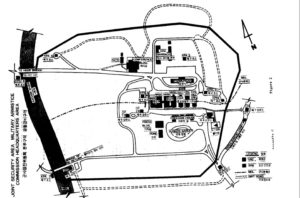
Source: United Nations Command, “Compliance with the Armistice Agreement,” UNC Regulation 551-4 (in Korean and English), April 25, 1986, released to Nautilus Institute under US Freedom of Information Act, at: https://nautilus.org/foia-document/armistice-affairs-compliance-with-the-armistice-agreement/
Continuing Risk at JSA
The defection of a North Korean soldier on November 13, 2017 by driving a vehicle to the northern side of the Military Demarcation Line in the partitioned JSA culminated in North Korean hot pursuit, crossing over the MDL (even if for only a moment before retreating), and firing from the northern side into the south at the North Korean defector who was hit while already across the MDL in the southern part of the divided JSA.[7] Prudently, US-ROK soldiers in the JSA did not fire back but waited and then sent soldiers to retrieve the wounded North Korean.
This event highlighted yet again the risks that forces that are directly arrayed against each other in closest proximity at the JSA is a site that could lead to exchange of fire, casualties, and escalation with almost no warning. Not only do tourists and other visitors constantly enter the JSA; but there is an ever-present risk of defection. Although uncommon, US soldiers in Korea have crossed the DMZ to defect to the DPRK in the past (although never through the JSA); and other North Korean defectors have crossed the DMZ minefields in the past to defect to the ROK. Moreover, scores of North Korean defectors have returned to the DPRK (although none via the DMZ or the JSA so far).
In short, sudden surprise events, the use of weapons, and subsequent escalation remain all too possible at the JSA. It is essential that the tension be reduced and underlying conditions that lead to defections be addressed while the Korean conflict is resolved in a comprehensive manner. This future management structure must address all the matters referred to in the Subsequent Agreements, not just the original Armistice.
III. ENDNOTES
[1] See Patrick M. Norton, “NAPSNet Policy Forum Online #2 — Norton, “Ending the Korean Armistice””, NAPSNet Policy Forum, March 29, 1997, https://nautilus.org/napsnet/napsnet-policy-forum/napsnet-policy-forum-online-2-norton-ending-the-korean-armistice/ and North Korean views at “DPRK Perspectives on Ending the Korean Armistice,” NAPSNet Policy Forum, #4 — May 7, 1997 at: http://www2.law.columbia.edu/course_00S_L9436_001/North%20Korea%20materials/4a_DPRKonKA.html
[2] The full text of the Korean Armistice may be found here: https://nautilus.org/publications/books/dprkbb/armistice/dprk-briefing-book-the-korean-war-armistice-agreement/
[3] 1976 Annual Historical Report USFK/EUSA, p. 7, released to Nautilus Institute under a US Freedom of Information Act request, at: https://nautilus.org/foia-document/1976-annual-historical-report-usfkeusa/
[4] See R. Probst, “Negotiating with North Koreans: The U.S. Experience at Panmunjom,” US Army War College, May 16, 1977, p. 11, released to Nautilus Institute under a US Freedom of Information Act request, at: https://nautilus.org/projects/by-name/foia/negotiating-with-north-koreans-the-u-s-experience-at-panmunjom/
[5] 1976 Annual Historical Report USFK/EUSA, released to Nautilus Institute under a US Freedom of Information Act request, at: https://nautilus.org/foia-document/1976-annual-historical-report-usfkeusa/
[6] United Nations Command, “Compliance with the Armistice Agreement,” UNC Regulation 551-4 (in Korean and English), April 25, 1986, released to Nautilus Institute under US Freedom of Information Act, at: https://nautilus.org/foia-document/armistice-affairs-compliance-with-the-armistice-agreement/ More recent versions of this regulation are found one line: HEADQUARTERS, UNITED NATIONS COMMAND, “COMPLIANCE WITH THE KOREAN ARMISTICE AGREEMENT,” UNC Regulation NO. 551-4
22 September 2003, p. B8, at: http://8tharmy.korea.army.mil/g1_ag/programs_policy/PublicationsRecords/Regulations/Unc_Cfc_Usfk/UNC%20Reg%20551-4%20Compliance%20with%20the%20Korean%20Armistice%20Agreeme(1).pdf This regulation was superseded in September 5, 2014, at: http://8tharmy.korea.army.mil/g1_ag/Programs_Policy/PublicationsRecords/Regulations/Unc_Cfc_Usfk/UNC%20Reg%20551-4%20Compliance%20with%20the%20Korean%20Armistice%20Agreement%20English.pdf
[7] A. Fifield, “Dramatic video shows North Korean soldier making a run for freedom,” Washington Post, November 22, 2017, at: https://www.washingtonpost.com/world/dramatic-video-shows-north-korean-soldier-making-a-run-for-freedom/2017/11/21/3a7f1fdc-cf2d-11e7-8447-3d80b84bebad_story.html?utm_term=.fb44f0345cf5
IV. NAUTILUS INVITES YOUR RESPONSE
The Nautilus Asia Peace and Security Network invites your responses to this report. Please send responses to: nautilus@nautilus.org. Responses will be considered for redistribution to the network only if they include the author’s name, affiliation, and explicit consent


